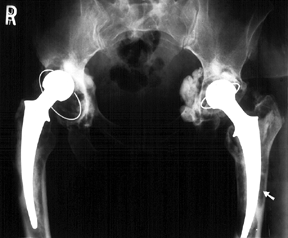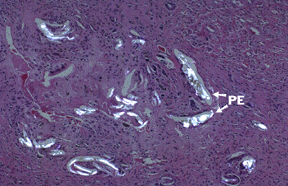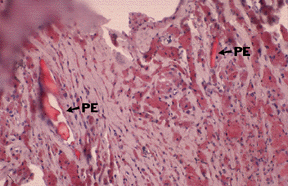
Modified Oil Red O Method for
Demonstration of
Polymeric Debris
In order to better identify fragments of polymers, (poly-ethelene,
polymethyl methacrylate and silicone), used in prosthetic implants,
the Orthopedic Histology Laboratory.subjected sections cut at 6
micrometers that were placed on glass slides to a modified Oil-Red-O
staining procedure. The modification consisted of increasing the
staining time in the Oil-Red-O staining solution from 24 hours to 5
days and increasing the time in the counterstain from 2 minutes to 10
minutes. This resulted in exceptionally well-defined polymers easily
identified within the paraffin embedded tissue sections.

X-ray of "failed" total hip replacement demonstrating
osteolysis secondary to polyethylene wear debris (arrow)
FIXATION: 10% buffered neutral
formalin.
TECHNIQUE: Cut paraffin sections
at six microns.
SOLUTIONS:
Oil Red O in Propylene Glycol
Solution
Oil Red O ............................0.5 gm
Propylene glycol, 100%....100.0 ml
Add a small amount of propylene glycol to the Oil Red O and mix well,
crush larger pieces. Gradually add the remainder of the propylene
glycol stirring periodically. Heat gently until the solution reaches
950C. Do not allow to go over 1000C. Stir while heating. Filter
through coarse filter paper while still warm. Allow to stand
overnight at room temperature. Filter through Seitz filter with the
aid of vacuum. If solution becomes turbid, refilter. When using the
Seitz filter, put rough surface of filter up.
85% Propylene Glycol Solution
Propylene glycol, 100% ...............85.0 ml
Deionized water ...........................15.0 ml
STAINING PROCEDURES:
1. Deparaffinize and hydrate to deionized water.
2. 100% propylene glycol - 5 minutes.
3. Oil Red O in propylene glycol. Filter before use. Leave slides in
solution for 5 days.
4. Differentiate in 85% propylene glycol solution for 2 ..minutes.
Agitate slides.
5. Wash in several changes of tap water.
6. Harris hematoxylin solution for 10 minutes.
7. Wash in tap water for 4 minutes.
8. Differentiate in 1% acid alcohol 1 dip.
9. Wash in tap water - 4 minutes.
10. Saturated lithium carbonate 1 dip.
11. Wash in tap water 4 minutes.
12. Coverslip in water based medium, (Elvanol).
RESULTS:
Polyethylene wear particles ..............cherry red
Nuclei ...............................................blue
(Method by F.B. Johnson, M.D.)

Polyethylene (PE) - H&E (75X)

Polyethylene (H&E) - polarized light (75X)

Polyethylene (PE) - Oil Red O (150X)
Inquiries can be directed to:
T.N. Vinh, M.D.
or D.E. Sweet, M.D., Chairman & Registrar
Department of Orthopedic Pathology
Armed Forces Institute of Pathology
Washington, D.C. 20306-6000
or phone (202) 782-2850, fax (202) 782-3149
Return to OrthoPath Home Page





